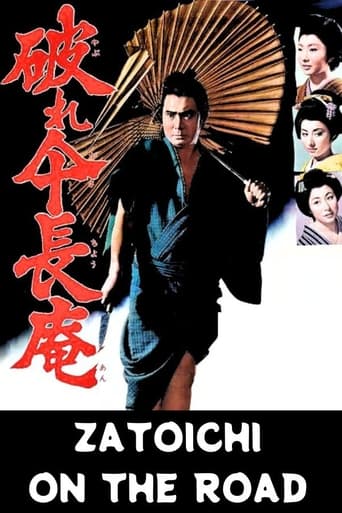mevmijaumau
I really disliked this one. When you see how generic the title "Zatoichi on the Road" is (doesn't he travel around in every movie?), you immediately get the feeling that this particular entry in the franchise is going to be bland and generic. And well, it ended up to be just that. The only things you can gather from this movie is that little kids during the Edo period were d*cks because they loved to mock blind people as it seems, and we also learn what Zatoichi's favorite fruit is (which I'm not going to reveal so that you have a reason to watch the film).The storyline to this film is a bit too reminding of Kurosawa's Yojimbo, which came out two years prior, and the similarities especially get apparent during the final showdown scene where the two rivaling yakuza clans are shown each on one side of the town. The main girl in this episode is unfortunately a screaming damsel in distress, but surprisingly there's no romance between her and Zatoichi. Most of the film is carried by a sluggish pace, which is occasionally broken by a short action scene, usually without build-up.Even on the technical scale is the film a massive step down from the previous episodes. Although the sword-fighting scenes gradually improve as the series go on, it is kinda stupid seeing someone be brutally cut up by a katana, only to face the camera in his dying breath to reveal that his clothes are neither torn nor bloody. I guess this movie was made during the time when real katanas were used on set, but some of its contemporaries nevertheless had awesome fight scenes, so I don't know. The visuals are quite lifeless this time. The movie is mostly shot in pitch black night settings and whenever it's daytime, it has a stunningly boring gray-to-brown color palette. Even the music seems too intrusive at several turns.Highlight of the movie: the cold opening where Zatoichi kicks ass swiftly and with style, also finding time to throw a killer one-liner, "Darkness is my ally." It's a shame that the rest of the film doesn't live up to the 30-second intro.
kurosawakira
This was the fifth Zatôichi film in just two years. It's been a while since I saw the last one in the series, but they're great fun. Simpler than the previous films, and also far more conventional as an action-adventure, "Zatôichi kenka-tabi" ('Zatôichi on the Road', 1963) stays true to its name, although it could've been called 'The Road To Edo' as well: a road movie of chasing and hiding, of fighting and fleeing to fight again; hide and seek, and pretense. The film greatly picks up in between the fights during the scene at the inn, which is well-made. And it is this sense of, well, it's not predictability because that sounds negative... let's say 'familiarity', that makes it so easy for the viewer to jump right into it – we know where it comes from and where it goes.It's become a running joke by now to have Zatôichi evade fighting, only to be eluded to a situation where he has to fight. He think he's only on a trip to Edo, while he's taken there to help out at a clan fight. The film is a crescendo of provocation until Zatôichi finally unsheathes his sword. This, of course, makes the films work in the long run: we need a sympathetic character, and having a character who would run around killing people for pleasure doesn't really cut it here. Yet there is a genuinely tragic undersong here: he doesn't search for trouble yet the trouble finds him, and still he is looking for trouble, as he says in the film, by having learnt to fight with the sword. My favourite moment is the one with the white sunshades on the slope, and Zatôichi running with the children in imitation of the ending of "Det sjunde inseglet" (1957), the other one is the Kurosawan climax.I do wonder when we're going to have a decent villain, though.
MartinHafer
I love the Zatoichi movies, though I have found that because they made so many and the plots tended to blend together so often, it is hard to distinguish them apart. I would give all of them about the same score of a 7 or an 8--with a few exceptions (the return of the original in 1989 was a TERRIBLE and depressing movie, while the new Zatoichi movie starring Beat Takeshi is probably the best of any Zatoichi movies).So why have I picked this one? Well, because it stands out a little from the rest in that it's a little better and more engaging. How Zatoichi defeated BOTH rival gangs at the movie's conclusion was spectacular and exciting to watch. In other words, he doesn't just beat ONE group of enemies, but two. So, if you want to see a Zatoichi flick, this is a good one to try.
eceltiu
When Zatoichi accidentally met an unknown dying man, who asked him to save an unknown maiden, he felt obligated. He didn't even have to promise. Time and again, he did everything in his power to save the maiden in several occassions. But when he took side on a feudal quarrel, he found himself choosing between which one to honor better: The request of a dying man or the contract he made with one of the gang leaders. You've guessed what he opted. Modern gangsters may have a different code of ethics.




